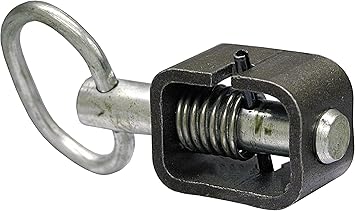I've recently acquired my first zero turn mower. I have a residential lot totaling about 1.5 acres that is sloped from about 10-15 degrees. As you might imagine, cutting on a 15 degree slope can be a bit of a challenge with a zero turn mower.
So much so that as a test, I decided to see if I could place my foot against the outside edge of the uphill caster fork to keep it from turning towards the downhill slope. This is actually quite effective, but also quite dangerous and not a long term solution by any means. But it does prove that the idea of momentarily or on-demand locking one or both casters in place can be effective for slope control.
I began thinking of ways in which to mechanically hold or lock the caster assembly in place during the long stretches across the yard. The means of hold would have to be easily swapped from free swivel to rigid caster travel (to allow for turns and manuevering around obstacles of course.
In my research, I have come across two examples: one commercial solution and one DIY solution.
First, here is commercial solution:
Second, here is a DIY solution:
Both of these solutions are similar in that they both address the problem of improving slope control and wheel traction for zero turn machinery.
However, both solutions appear to be fairly finely tuned for the platform in which they are attached to.
My idea is to discuss an approach to the problem in a simpler manner that would have the potential to be applied to a wide range of existing zero turn mowers and machines using the simple idea of a swivel caster locking mechanism paired to a .5 inch square slot cut out on the caster fork.
Here is a video in which the general technique is described:
As you can see from the video, a simple latch mechanism, paired with a slot cutout, can act as a key/lock mechanism to regulate the caster's motion between rigid and swivel.
What are your thoughts on this idea?
I'm thinking that an ideal solution would be a universal add-on device consisting of a movable spring loaded bolt/latch designed to interlock with the caster fork cutout.
The utility of the device would be greatly enhanced if it could be actuated with a mechanical lever. Either foot control toggle or cable actuated with a mechanical switch lever that could be mounted close to the operator seat position.
So much so that as a test, I decided to see if I could place my foot against the outside edge of the uphill caster fork to keep it from turning towards the downhill slope. This is actually quite effective, but also quite dangerous and not a long term solution by any means. But it does prove that the idea of momentarily or on-demand locking one or both casters in place can be effective for slope control.
I began thinking of ways in which to mechanically hold or lock the caster assembly in place during the long stretches across the yard. The means of hold would have to be easily swapped from free swivel to rigid caster travel (to allow for turns and manuevering around obstacles of course.
In my research, I have come across two examples: one commercial solution and one DIY solution.
First, here is commercial solution:
Second, here is a DIY solution:
Both of these solutions are similar in that they both address the problem of improving slope control and wheel traction for zero turn machinery.
However, both solutions appear to be fairly finely tuned for the platform in which they are attached to.
My idea is to discuss an approach to the problem in a simpler manner that would have the potential to be applied to a wide range of existing zero turn mowers and machines using the simple idea of a swivel caster locking mechanism paired to a .5 inch square slot cut out on the caster fork.
Here is a video in which the general technique is described:
As you can see from the video, a simple latch mechanism, paired with a slot cutout, can act as a key/lock mechanism to regulate the caster's motion between rigid and swivel.
What are your thoughts on this idea?
I'm thinking that an ideal solution would be a universal add-on device consisting of a movable spring loaded bolt/latch designed to interlock with the caster fork cutout.
The utility of the device would be greatly enhanced if it could be actuated with a mechanical lever. Either foot control toggle or cable actuated with a mechanical switch lever that could be mounted close to the operator seat position.







